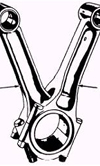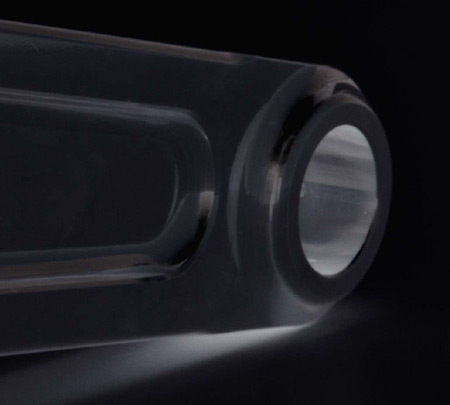Avoiding the need to stagger
 After inventing the internal combustion engine, it became clear that man always wanted more power, not only for racing and record-breaking, but also for his road vehicles. Today we have road-going production motorcycles that are more powerful than their Grand Prix counterparts of 15 years ago.
After inventing the internal combustion engine, it became clear that man always wanted more power, not only for racing and record-breaking, but also for his road vehicles. Today we have road-going production motorcycles that are more powerful than their Grand Prix counterparts of 15 years ago.
The merits of using multiple cylinders are well known, and to make compact engines with larger numbers of cylinders, 'vee' engines are a good solution. Most bespoke race vee engines have two con rods running on one crankpin, with each rod offset from the centre of the crankpin. The rod is positioned centrally with respect to the piston that operates it, and therefore the cylinders on each bank are offset by the same amount, as are the con rods.
Selecting the correct bearing size is dictated by the combustion pressure and the bore area; for a given pressure limit on a bearing and surface speed, bearing area is proportional to piston area. In general, we can therefore say that bigger-bore engines will require bigger bearings and, as bearing width dictates the width of the big end of the rod and therefore rod offset, the bank-to-bank stagger of the engine will be correspondingly larger. For a given engine capacity, bigger bores mean a shorter stroke, giving the opportunity to run to higher engine speed and increase power output. Bank-to-bank stagger has an effect not only on engine length, but also on engine mass. It stands to reason that, all other things being equal, a longer engine is a heavier engine.
Engine length also has an effect on engine stiffness and, where engines are a structural member in the chassis (fully or semi-stressed), any increase in engine stiffness is generally welcomed by the chassis designer.
Even where engine mass is limited to a certain minimum, as in Formula One, there is an advantage in having a shorter engine. While the potential mass saving is not realised, the 'spare' material can be used to advantage to produce a stiffer engine.

Given that our business is to produce small, light engines, how can we reduce this bank-to-bank stagger? Well, we can turn to our old books on race engines to see how this was achieved in the past. With bearing materials of relatively poor performance compared to today's engines, and large cylinders - often supercharged - we might reasonably expect that racing aero engines of the 1920s and '30s would have a large bank-to-bank stagger. The reality is that many were designed to run zero bank stagger by using one of a number of con rod designs.
One popular solution was to use a 'fork and blade' rod assembly. A conventional con rod (known as the 'blade' rod) is run in the centre of the crankpin, and a forked rod operated by the piston on the opposite bank, running two smaller bearings also run centrally on the crankpin, with its bearings running either side of those on the blade rod. There are variations on this scheme, and also other ways of achieving the same goal of zero bank stagger.
Fig. 1 - A 'fork and blade' con rod, typical of those used in old V12 piston aero engines
Written by Wayne Ward